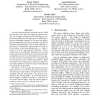Free Online Productivity Tools
i2Speak
i2Symbol
i2OCR
iTex2Img
iWeb2Print
iWeb2Shot
i2Type
iPdf2Split
iPdf2Merge
i2Bopomofo
i2Arabic
i2Style
i2Image
i2PDF
iLatex2Rtf
Sci2ools
INFOCOM
1997
IEEE
1997
IEEE
Analysis of Queueing Displacement Using Switch Port Speedup
Current high-speed packet switching systems, ATM in particular, have large port bu
ering requirements. The use of highly integrated ASIC technology for implementing high-degree and high-speed switch fabrics is facing a technology mismatch in the sense that today's chip technology does not allow to integrate on-chip the high-speed switching fabric with the large bu
ering requirements. Consequently, many designs are based on the principles of queueing displacement, i.e., they attempt to move the queueing point o
-chip. This is usually done by considerably speeding-up the on-chip switch output ports and placing a second external stage of bu
ering between the switch fabric and the outgoing link circuitry. Such designs are very popular and are used by many current ATM switch vendors. While such schemes are widely used, no rigorous analysis has so far been o
ered to evaluate the design trade-o
s and to quantify the design points. The model we use to analyze the performance of the above...
| Added | 06 Aug 2010 |
| Updated | 06 Aug 2010 |
| Type | Conference |
| Year | 1997 |
| Where | INFOCOM |
| Authors | Israel Cidon, Asad Khamisy, Moshe Sidi |
Comments (0)

